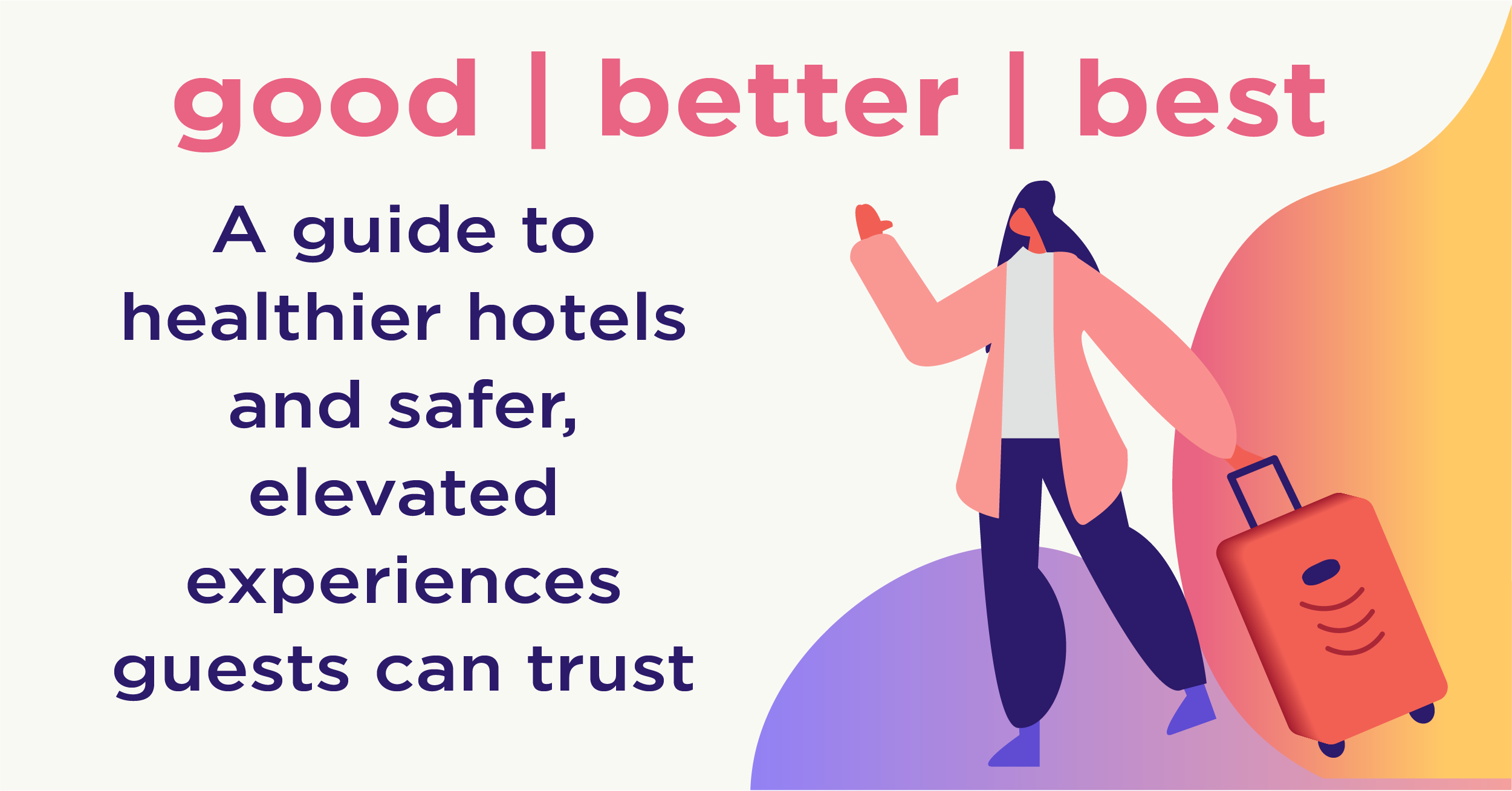
By: tvsdesign Hospitality
Gone are the days where we can last-minute book a trip on a whim, jump on a plane and arrive at our destination with a carefree attitude and without thinking twice about catching a virus. Just like those willing to pay an arm and a leg to secure the last hand sanitizer and 6-pack of toilet paper from their local grocery store, consumers are likely to be even more discerning about which hotel will receive their business moving forward. This shift in thinking could result in greater investment from travelers looking to stay at a hotel that meets standards set by expectations that previously did not exist going into 2020, even if the room rate is outside their original budget. Think of best–in–class cleaning and disinfectant programs as the hottest new hospitality amenity.
In the meantime, how can hotels use this logic to prepare their spaces appropriately, even if it means an improvement project outside of their current allotted capital expenditures? Better yet, how can they afford not to? For all intents and purposes, the hospitality industry is currently on pause, so this may be the perfect opportunity to undertake health and wellness upgrades to properties that are temporarily at minimal occupancy levels.
No doubt these new measures will affect hotel owner’s out–of–pocket costs, so understanding that occupancy is down and budgets might be tight, we’ve outlined a ‘good > better > best’ approach to help hotel owners and operators understand improvements that can be made to their spaces, building systems and components in order to meet the new expectations of future guests.
GOOD
Good is the baseline that’s required to make guests feel like the hotel is taking guest health seriously. These are generally quickly implementable, low-cost steps that may not be “permanent” solutions but will get the building operating in the immediate crisis.
Disinfecting protocols
Operationally, hotels are providing a hand sanitizer stand at nearly every threshold, sometimes even providing complimentary disposable masks and gloves. Some have upped the ante with which cleaning supplies they use, switching to medical-grade standard disinfectants set by the CDC. These protocols should be implemented across the property – lobby, reception, meeting spaces, restaurant and guestrooms. No stone (or space) should be left unturned when it comes to disinfecting.
Self-sanitizing stations
Whether checking in, entering a dining facility, or getting out of an Uber, people will be searching for a place to sanitize themselves after every touch point. We envision these sanitation stations beyond just a free–standing hand sanitizer product. These stations can be a well-designed piece that is integrated into casework or even an outdoor component that sparks joy when interacting with it all while efficiently sanitizing your hands.
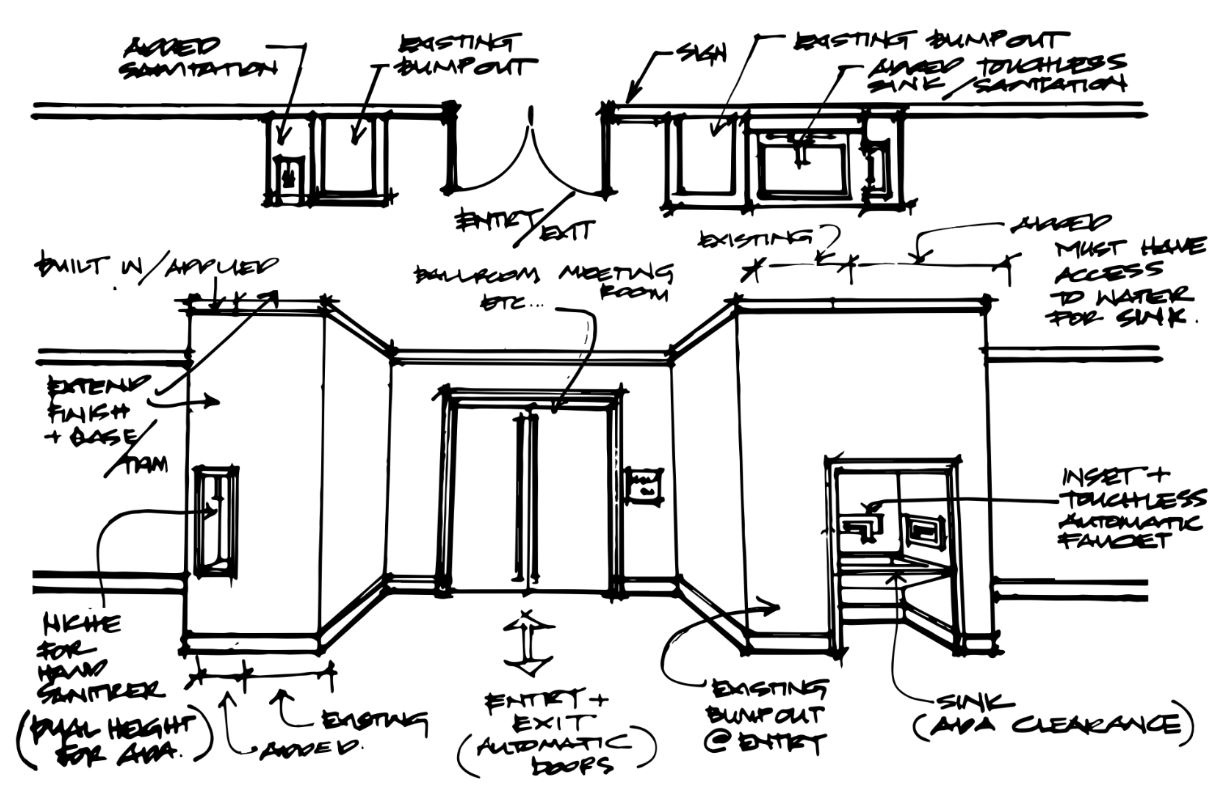
“Consider providing more places for guests to wash and sanitize their hands, separate from the public restrooms.”
High-traffic automation
High–traffic entries and exits should be on an automatic opener moving forward – preferably motion sensor activated to avoid having to touch a button. These areas should be prioritized, including the entrance to the lobby and main entrances to ballrooms and restaurants.
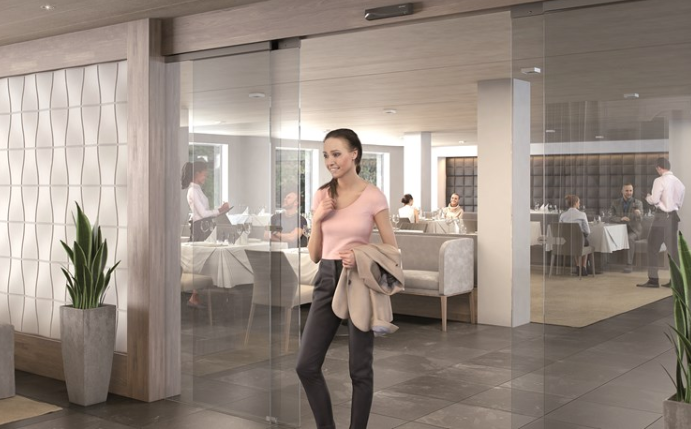 Image provided by ASSA ABLOY
Image provided by ASSA ABLOY
Hands-free public spaces
Our colleagues at Assa Abloy, an entrance solutions group, say that while automatic openers may not in the budget to be implemented across the property, there has been unique hands-free door hardware introduced to the market that allows the door handle to be pulled open without having to grip anything by hand. There are even some options to use your foot, making these openers a great choice for doors going in and out of public restrooms that don’t require a latch closer.
In public restrooms, updates that make fixtures and equipment automatic may become expected in the future. Research shows that high-speed hand dryers can spread airborne bacteria, so replacing with automatic paper towel dispensers might become a priority. Sensor–activated flush valves for toilets, faucets and soap dispensers are also preferred, and may represent a relatively affordable upgrade.
HVAC and Air Flow
The first step in improving air quality and reducing risks is to “recommission” the HVAC, plumbing and lighting systems. Before any modification is considered to these systems, one should make sure they are running correctly as designed. Things happen over time and adjustments are made, and they tend to get out of alignment each year.
According to the team at TLC Engineering Solutions, increasing ventilation rates help dilute airborne aerosols which is believed to reduce the risk of the spread of viruses. Disabling demand control ventilations systems and nighttime purge strategies can further increase the air changes in existing spaces. Temperature and humidity control should also be a priority. ASHRAE’s ‘optimal zone’ recommends a 40% to 60% humidity level in the summer months.
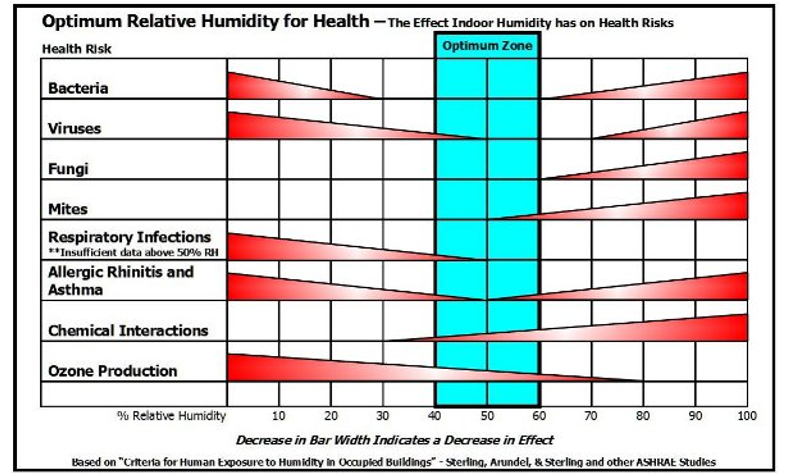 Image provided by TLC Engineering
Image provided by TLC Engineering
Guestrooms typically use recirculated air for each individual room. In order to reduce risks to the occupant from anything they release in the air, enhanced filtration with a higher MERV 15 rated filter should be considered for these systems. Maximizing the amount of fresh air, a system is designed to process is a good short–term modification. While this will negatively impact energy costs, and should be looked at after the immediate crisis, the increased ventilation rates have shown a correlation to reduced infection risks.
When it comes to positive and negative pressure, efficiently zoning a building will help prevent air movement from one zone to another. It is best practice to pressurize from low risk to high risk. Areas with high levels of particulate are normally under negative pressure relative to spaces with low levels of particulate. For example, ideally kitchens would have a negative pressure compared to an adjacent dining room which would have a positive pressure.
BETTER
In the “better” category are improvements that will likely require budgeting this year for capital expenditures next year. This includes permanent solutions that may “un-do” some of the band-aid solutions in lieu of better long-term solutions.
Antimicrobial finishes
Door hardware can be finished with a non-toxic, anti-bacterial ‘MicroShield’ that prevents growth of bacteria, algae, yeast, fungi, mold and mildew on the surface. Coatings such as MicroShield lasts the life of the hardware and can be useful on other public access doors that are secondary to a main entrance of a space, further controlling the spread of numerous strains of bacteria. Taking inspiration from healthcare, owners should strive to use more hard surfaces that are easy to clean and have anti-microbial qualities.
“Bluetooth key access can help prevent not only the germs passed by reusable cards but also have a positive impact on the environment with the reduction in waste.”
Mobile access
Access to guestrooms have seen a major shift in the past few years, allowing guests to bypass the front desk interaction and access their room through an app on their phone.
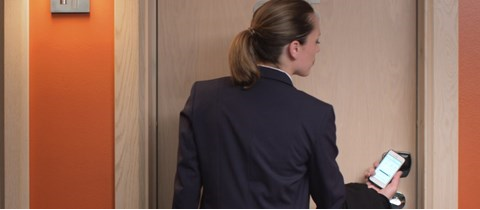 Image provided by ASSA ABLOY
Image provided by ASSA ABLOY
With key functionality moved to your phone, other services like requesting room service can be done through an app. Purchasing meals and requesting other services through a mobile app, as well as integration of other scan-and-go features, can help avoid interaction with a traditional touch-based POS system.
HVAC and Air Flow
In public spaces, providing energy recovery can offset the higher energy costs of higher ventilation rates and increase dilution in the spaces served. Using HVAC systems to control air pressure relationships can help prevent the transmission of exhaust into an adjacent space. An increase in natural ventilation, not just by adding more openings to the building exterior, should also be a priority for bringing clean air to public spaces. Introduction of natural ventilation is climate specific and needs to be “designed” so that mold and humidity damage to surfaces is minimized.
Increased filtration levels in the guest rooms can usually be accomplished, but the impact of the higher static pressure drop to the small fan motors in the room units must be considered. Increased filtration in the larger public area units can usually be accommodated with minor duct and equipment modifications.
Adding UV–C lights to the insides of the AHUs serving larger spaces, aids in keeping the coils clean. This can best be described as improving the coil cleanliness, not necessarily a COVID-specific strategy.
Ventilation air to the guestrooms and corridors should be reviewed. Consider providing additional exhaust to guest room bathrooms to keep the guest rooms air pressure neutral to the common corridor. Corridors should be pressurized at a recommend rate of 2 air changes per hour. Guest room energy recovery units that minimize cross contamination between the exhaust and supply air should be used.
BEST
Consideration of the future viability of the asset might mean that time and expense are secondary to guest well-being, and that the property sees best–in–class wellness and sanitation as a differentiator.
Hands-free guest entry
The pinnacle of a touchless guest experience is the convergence of all the available technology to provide a completely ‘hands-free’ experience from street through check-in and to the guest room. Installing auto operators on all guest room doors, allowing for guests to wave their phone ‘key’ in front of a sensor, will prompt the door to open automatically (just make sure to yell ‘OPENSAYSME’ or it won’t work...)
“Elevator buttons are a frequently touched item by many but with new technology, users can call an elevator and request their floor through voice activation.”
Some elevators are equipped with a key card slot so when you insert your hotel key, it takes you to the floor of your room without having to push a button. Even more advanced are the Bluetooth enabled elevators that use geo-fencing from your phone so when you approach the elevator and step in, the elevator uses the information from the hotel’s app to send you to the floor you are staying on.
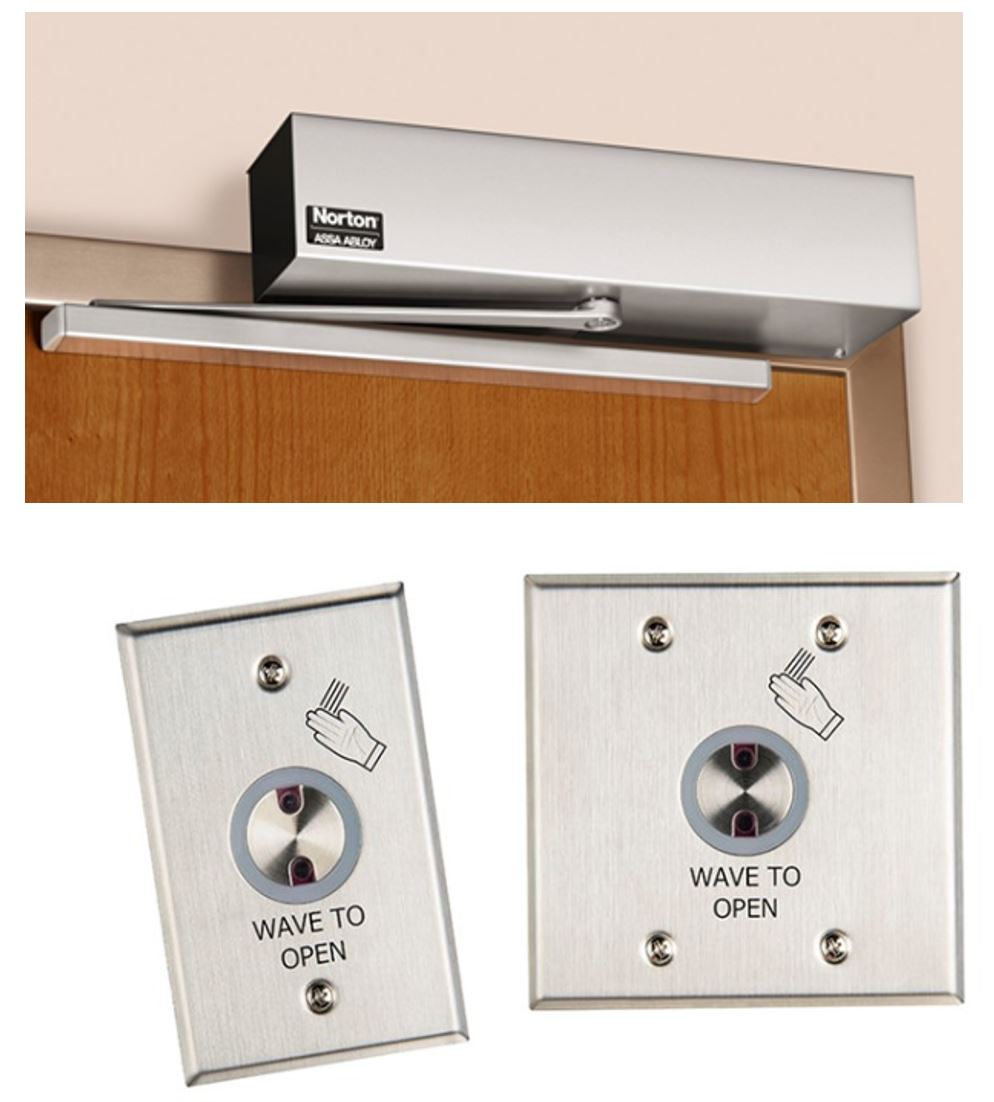 Image provided by ASSA ABLOY
Image provided by ASSA ABLOY
Ventilation
Upgrades to ventilation are one of the most meaningful improvements a building owner can make in the fight against infection. While building in displacement ventilation or underfloor air distribution can carry a significant increase in cost, this type of system is known to provide an increase of ventilation effectiveness and allows the natural movement of heat and air. The upward movement of the air within the room has shown to reduce the total particulate levels in studies.
Redesigning the HVAC system to focus on air quality can be a long-term asset repositioning strategy. There are low-cost air quality monitors that can monitor and report contaminants in a space. This data can be reported out to achieve “RESET” certification, which lets people know that based on data, your building has verifiably good air quality. An April 2020 Harvard study indicates that if your health is already compromised by prolonged exposure to PM2.5 pollution, you’re at a high risk of suffering from COVID-19. A long–term strategy to demonstrate better air quality in the space and communicate that out may be of interest.
Once you know the air quality in the space, you must locate the polluting source and eliminate it, then the HVAC / ventilation system should be a part of remediating the problem.
 Reducing bacteria growth through UV-C light
Reducing bacteria growth through UV-C light
UV-C light has seen an insurgence as people are looking to integrate this technology in any form to disinfect passively. It’s not an ‘immediate’ sanitation, but rather a way to keep surfaces from growing bacteria without having to constantly clean with harsh chemicals. We see this technology integrated from front of house operations, to back of house systems. If your associates use tablets to coordinate tasks, these devices can remain under a UV-C light to disinfect quickly before the next associate grabs to use it. It is important to introduce UV-C light where there is no chance it will be directly seen by the human eye due to potential damage to one’s sight
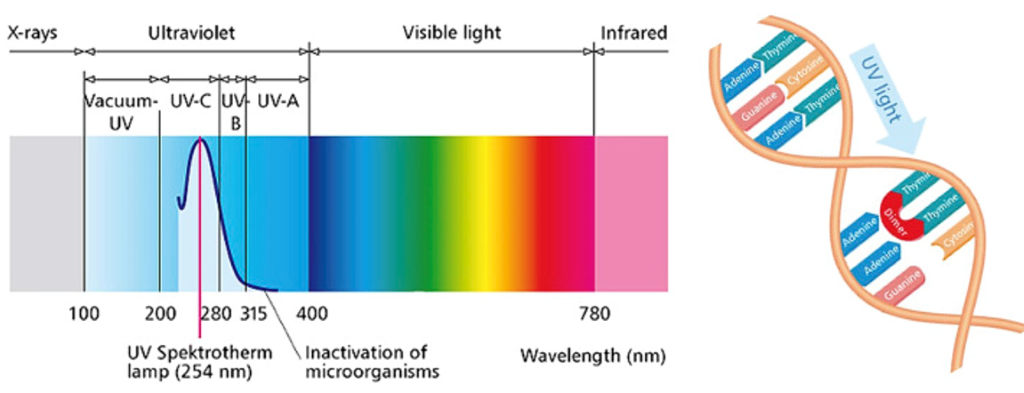 Image provided by TLC Engineering
Image provided by TLC Engineering
There is potential to use UVC lights to wash the ceiling of public restrooms. These are high viral density areas, and over time the UV–C light in the ceiling area can help reduce the viral populations. UV–C lights are hazardous to humans if there is direct skin or eye exposure, so using them in targeted areas, accessible only by trained maintenance staff is a way to provide the benefit while minimizing risks.
Wellness-driven design
When it comes to programming and building layout, a ‘wellness-focused’ design that encompasses multiple aspects of the built environment is the best approach. Spatially, wider circulation areas that promote less dense gathering will allow for easier social distancing. Looking at materiality, lighting, greenery, air and sound quality and indoor-outdoor space integration are a few key components that influence design. Also, using the WELL standard approach in these areas in addition to water conservation, life cycle issues, carbon neutral and many others can make a space feel comfortable, sanitary and functional, all while being aesthetically pleasing.
TAKEAWAYS:
In the near term, we believe that some level of increased health and sanitization upgrades will be necessary to allay the concerns of a frightened and apprehensive traveler. Thinking bigger, it’s possible that the current health crisis could serve as an opportunity to make meaningful changes and upgrades that will differentiate certain properties and inspire heightened loyalty and trust.
The challenge lies in finding the right balance between integrating every bell and whistle available on the market with cost and the practicality of undertaking potentially major renovations. A practical solution suggests focusing on the areas that impact the largest footprint, improve the overall guest experience, and that make a meaningful impact towards reassuring guests that their safety and well-being is a priority. As travelers begin to return, taking a balanced approach to common-sense safety and sanitation measures will cultivate a welcoming and meaningful guest experience.
Special thanks to our colleagues at TLC Engineering and Assa Abloy for sharing their deep well of knowledge and providing these invaluable resources that will help hoteliers move forward on their road to reopening.
Need a hand evaluating your reopening plan? Our team of Hotel consultants are here to help:
[gravityform id=”6″ title=”false” description=”true”]



